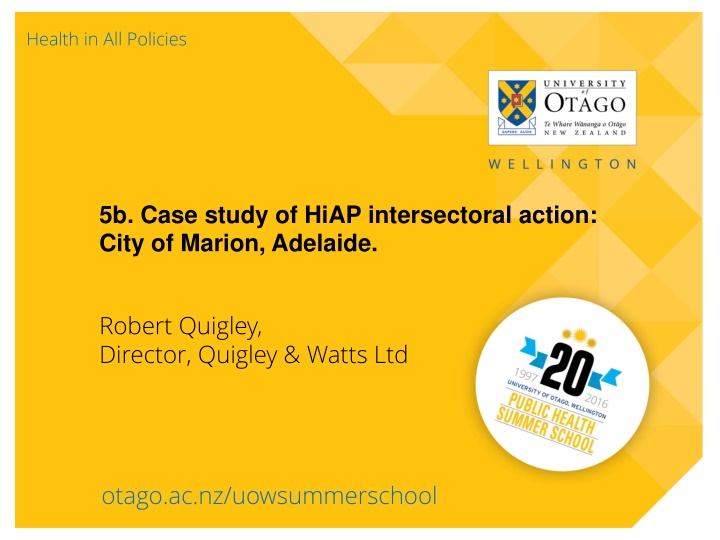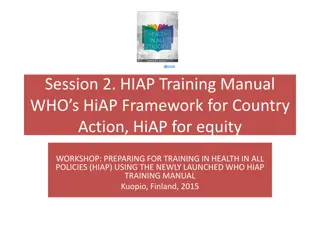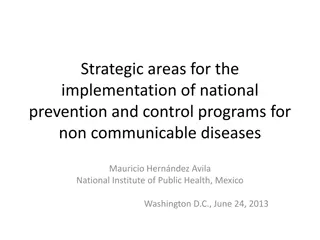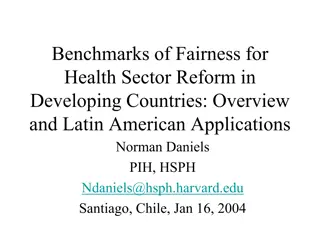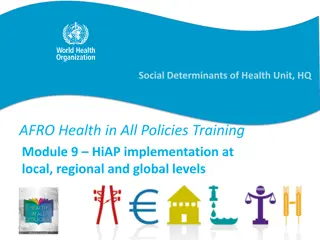Health in All Policies: Case Study of Intersectoral Action in City of Marion, Adelaide
The case study highlights the process of implementing Health in All Policies (HiAP) in the City of Marion, Adelaide, focusing on establishing needs, framing planned actions, identifying supportive structures, facilitating assessment, and engaging key stakeholders. The initiative covers various determinants such as public transport, climate change, healthy food access, employment, healthy environment, physical activity, mental health, social inclusion, biodiversity, and more.
Download Presentation

Please find below an Image/Link to download the presentation.
The content on the website is provided AS IS for your information and personal use only. It may not be sold, licensed, or shared on other websites without obtaining consent from the author.If you encounter any issues during the download, it is possible that the publisher has removed the file from their server.
You are allowed to download the files provided on this website for personal or commercial use, subject to the condition that they are used lawfully. All files are the property of their respective owners.
The content on the website is provided AS IS for your information and personal use only. It may not be sold, licensed, or shared on other websites without obtaining consent from the author.
E N D
Presentation Transcript
Health in All Policies 5b. Case study of HiAP intersectoral action: City of Marion, Adelaide. Robert Quigley, Director, Quigley & Watts Ltd otago.ac.nz/uowsummerschool
1. Establish the need and priorities for HiAP The groundwork and relationships for intersectoral action had been laid for quite some time, including: SA Strategic Plan SA Government adopts HiAP approach after Illona Kickbusch 2007 Thinker in Residence HiAP unit at SA Health 30 Year Plan for Adelaide for higher density areas of good practice 2
2. Frame planned action Collaborative development of Healthy Transit Oriented Developments (TOD) Principles by the: - Department of Health - Department of Planning and Local Government - Department for Transport, Energy and Infrastructure - Land Management Corporation. 3
3. Identify supportive structures and processes An upcoming (mandatory) Development Plan Amendment for the Castle Plaza site, overseen by Marion City Council was highlighted as a space to work together to try out the Healthy Principles Planning for this level of the collaboration included: - who was the lead agency (Marion City Council) - support from whom (four government departments and financier) - resources needed to do the work (added in a contractor). 4
4. Facilitate assessment and engagement The health impacts were assessed for the Castle Plaza Development using an innovative health and wellbeing assessment. The assessment was attached to the Development Plan Amendment process. Key stakeholders were engaged in the development of the assessment. They scored their own plan against the assessment tool, and developed their own recommendations Process is important everybody bought into the results. 5
The determinants covered were Accessible public transport Climate change Access to healthy food Employment and workplace access Healthy environment Physical activity Sustainability and vibrancy Mental health and wellbeing Social inclusion and cohesion Sense of place Biodiversity
Figure 1. Upper and Lower Bounds with Criteria Scores 4 3 2 Upper bound Score Lower bound Score 1 0 -1 CPTED Employment and economic diversification Noise, indoor public realm Noise, outdoor in public realm Travel modes Permeable neighborhoods High amenity streetscapes Greenhouse gas emissions Outdoor air quality Connectedness Net housing density Public transport access Education and training services Water use Water sensitive urban design Integration of land uses Creation of public open spaces Diverse type and size of businesses Active transport Assessment criteria
Results 48 changes suggested overall All changes have been made to the final DPA.
Support factors At the assessment-level, four supporting aspects were required: A set of principles against which the proposal could be assessed, in this case the Principles for a Healthy Transit- Oriented Development (already available). A thorough understanding about the proposal being assessed, in this case the Castle Plaza Development Plan Amendment (provided by the participants). A thorough understanding of the decision-making process, to tie into, and so that recommendations for change could be useful (provided by the participants). Excellent working relationships between the key stakeholders.
Questions for you: Which determinants of health might be able to be covered in such an assessment? Who might be involved in the assessment process which stakeholders? 11
